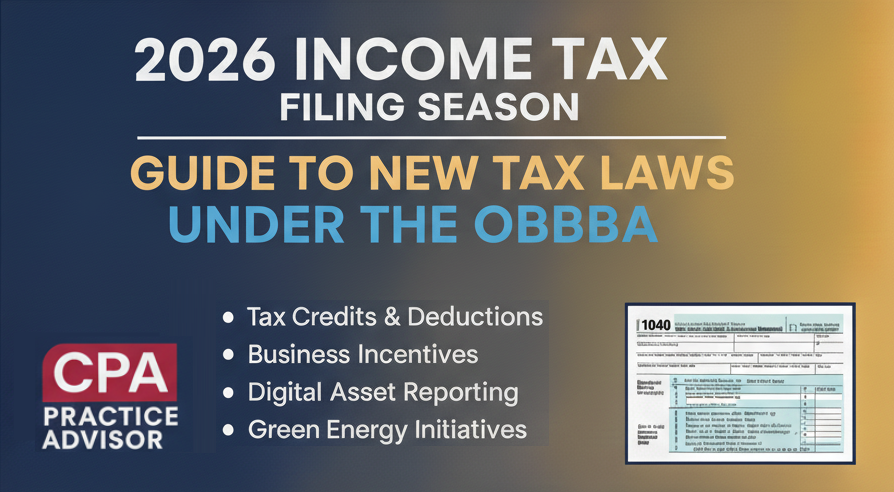Have you read the new tax reform law yet? Officially called the Tax Cuts and Jobs Act (TCJA), the new tax reform law is more than 500 pages long, so we’ll spare you the gory details. Most of the key provisions likely to affect individual taxpayers take effect in 2018 (for taxes that will be reported by April 2019), but are scheduled to sunset after 2026. Keeping that in mind, here are the essentials you should know about.
[This article explores the impacts of the new tax reform law on individual taxpayers. Click here to read how the law affects business taxes.]
Individual tax rates: The TCJA replaces the current rate structure with seven rates of 10%, 12%, 22%, 24%, 32%, 35% and 37%. It also adjusts the income ranges for the brackets to mainly benefit upper-income taxpayers. In addition, the new law replaces the Consumer Price Index (CPI) use for indexing with a “chained CPI index” that is expected to reduce inflation adjustments in the coming years.
Standard deduction and personal exemptions: The new law effectively doubles the standard deduction to $12,000 for single filers and $24,000 for joint filers. At the same time, it eliminates all personal exemptions, including those for qualified dependents, along with the personal exemption phaseout (PEP) rule.
Child tax credit: The TCJA doubles increases the child tax credit (CTC) from $1,000 to $2,000 and raises the refundable portion of the CTC to $1,400. In addition, it authorizes a $500 nonrefundable credit for non-child dependents for taxpayers who don’t claim a CTC.
Kiddie tax: The kiddie tax continues to apply to annual unearned income above a specified amount ($2,100 in 2018) received by a child under age 19 or a full-time student under age 24. However, the tax is now calculated under the tax rates for estates and trusts,
Itemized deductions: The TCJA wipes out several itemized deductions and modifies others in conjunction with the repeal of the “Pease rule” reducing deductions for upper-income taxpayers. Some of the key changes are:
- The new law limits deductible mortgage deduction to interest paid on the first $750,000 of new acquisition debt, down from $1 million. No deduction is allowed for interest paid on home equity debt.
- The deduction for state and local taxes (SALT) is limited to $10,000 a year. This may include (1) property taxes or (2) income taxes or sales taxes or (3) a combination of the first two.
- Casualty and theft loss deductions are eliminated, except for losses occurring in federal disaster areas.
- The deduction for miscellaneous expenses subject to the floor of 2% of adjusted gross income (AGI) is repealed. This generally consists of production-of-income expenses, such as tax advisory fees, and unreimbursed employee business expenses.
On the plus side, charitable deductions are preserved, with certain minor modifications. Also, the floor for deducting medical expenses is restored to 7.5% of AGI, the limit prior to the Affordable Care Act (ACA), for the 2017 and 2018 tax years. In other words, this change is retroactive and might benefit taxpayers on their 2017 returns.
Alternative minimum tax: The new law enables many taxpayers to avoid the dreaded “alternative minimum tax” (AMT) in 2018. It increases both the exemption amounts and the thresholds for phasing out the exemptions so only the top echelon of taxpayers will be liable.
Section 529 plans: The new law expands use the use of Section 529 plans to cover $10,000 of annual expenses for public or private K-12 schools Previously, use of 529 funds was limited to higher education expenses.
Moving expenses: The above-the-line deduction for job-related moving expenses is repealed, except for active duty military personnel. In addition, the tax exclusion for moving expense reimbursements is no longer available.
Alimony deductions: The new eliminates the alimony deduction for payors, and the corresponding taxable income for recipients, for divorce or separation agreements entered in to after 2018. So there’s still time to incorporate the current tax principles into a decree in 2017.
IRA recharacterizations: The rule permitting a taxpayer to undo a Roth conversion from a traditional IRA is repealed. It‘s not yet clear of such a recharacterization will be allowed for a Roth conversion that was made in 2017.
Estate tax: The maximum federal estate tax exemption is doubled from $5 million to $10 million. With inflation indexing, the exemption is expected to be $11.2 million for 2018. Thus, with the help of the “portability” provision, a married couple can effectively shelter up to $22.4 of assets from estate tax.
Health insurance: The individual insurance mandate required by the Affordable Care Act (ACA) is abolished. However, this change doesn’t take effect until 2019. Note: The new law doesn’t address other taxes imposed by the ACA, including the surtax on net investment income (NII), the 0.9% additional Medicare tax on wages and the medical device tax.
Perhaps the biggest takeaway for many of your clients will be a shift from itemizing deductions to the standard deduction. Despite the charitable deduction and medical deductions being preserved, the cutbacks in other tax breaks —especially the SALT deduction — could be conclusive. But don’t make any assumptions. Each situation should be analyzed on its own merits.
How do most of your clients fare overall under the new tax law? You can use the calculator at https://www.marketwatch.com/story/the-new-trump-tax-calculator-what-do-you-owe-2017-10-26, provided by MarketWatch for a quick assessment. Various other calculators can be found online, including this one: http://taxplancalculator.com. But there’s no real substitute for working through all the numbers. Then you can help your clients plan accordingly.
Finally, remember that the main changes for individuals are set to expire after 2026, if not sooner if Congress reverses its direction. So we could be muddling through this exercise again in the not-so-distant future.
Thanks for reading CPA Practice Advisor!
Subscribe Already registered? Log In
Need more information? Read the FAQs
Tags: Income Taxes, IRS




